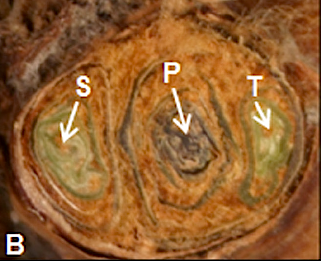The severity of the current winter weather has growers and ag agents questioning how to accurately assess vineyard damage and develop a plan for coping with the damage through cultural management.
Fruit Specialist Dan Ward supplies comprehensive answers.

Cross sections of grapevine compound buds showing the location of primary (P), secondary (S), and tertiary (T) buds.
P bud is dead, while S and T buds are alive.
Photo courtesy WSU Extension
The hardiness of grape buds and wood ranges widely among cultivars and different antecedent weather and physiological conditions. Any estimate of cold hardiness needs to be considered as specific to either the buds or the wood, given the cultivar, under the previous Fall’s conditions for the development of hardiness, given the weather conditions preceding the cold event in question. So, for instance, to predict what temperature would kill 50% of the grape buds on a vine, we would need to assume that good physiological “ripening” of the wood occurred in the Fall (which we generally had in 2013), and we need to consider the weather conditions that preceded the cold event.
As with other woody plants, warm temperatures during the dormant season can deharden the tissues. Conversely, consistently cold temperatures help the tissues withstand the coldest temperatures that they are capable of tolerating. In general it takes many days of consistently cold temperatures for dormant tissues to reach maximum cold hardiness. Warm or fluctuating temperatures preceding a cold event can deharden the tissues and reduce hardiness even when there are cold nights occurring. The cold events in the first week of January were preceded by fluctuating temperatures and likely resulted in uneven hardiness, with poor cold hardiness in some areas and much better hardiness in others. In much of the state the first two critical cold events in January probably caused substantial damage to grape buds because the buds weren’t sufficiently cold hardy and the temperatures were quite low in some areas.
The first event (January 3rd) was on a calm night with sizable differences in minimum temperatures between different sites – even sites that were not far apart. So, there may have been damage in one site but not another nearby site from that event. The second event (January 7th) was accompanied by considerable wind as part of a large cold air mass, which resulted in more even temperatures among nearby sites. Temperatures were probably cold enough to cause damage on both of those nights. The succeeding cold events in late January (January 23rd January 30th) were preceded by several days of consistent cold and likely the remaining live tissues had developed significantly more cold hardiness and probably suffered much less additional damage than could have otherwise been the case.
Generally buds can not tolerate as much cold as wood (canes and trunks) most of the time. But the tissues in the wood vary in their cold hardiness and can often suffer damage easier than expected. Wood damage is often difficult to assess and sometimes isn’t evident until late in the growing season following the damage. Some wood injury heals well without visible effects. Other wood damage can result in vine death or development of crown gall infections at the sites of cold injury. We haven’t seen injury to the wood in the vines here in the southern part of the state, but we will have to see what 2014 shows us.
The bulletin from Michigan State “Winter Injury to Grapevines and Methods of Protection” by Zabadal et al. provides a table of critical temperature ranges for different classes of grapes. The critical temperatures are those temperatures that would kill 50% of the primary buds. Remember that these critical temperatures are the range of temperatures that the fully hardened buds can achieve. In brief:
- Very tender grapes: 5 to -5F. This includes many Vitis vinifera e.g. Merlot, Syrah, Sauvignon blanc, Zinfandel.
- Tender grapes: 0 to -8F. This includes also includes many Vitis vinifera e.g. Chardonnay, Cabernet Sauvignon, Pinot Noir, Pinot grigio, Gewurztraminer.
- Moderately tender grapes: -5 to -10F. This includes some Vitis vinifera and some hybrids e.g. Riesling, Cabernet franc, Chambourcin.
- Moderately hardy grapes: -10 to -15F. This includes many hybrids e.g Cayuga White, Chardonel, Traminette, Norton, Seyval blanc, Vignoles.
- Hardy grapes: -15 to -20F. This includes mostly Vitis labrusca e.g. Concord, Catawba, Delaware, Niagara.
- Very Hardy grapes: -20 to -30F. This includes some hybrids e.g. Frontenac, Marechal Foch, LaCrescent.
We can make predictions of what has likely happened, but assessment of bud damage by careful evaluation of dissected buds is required to get an accurate estimates of damage for any vineyard and definitely to develop a plan for coping with the damage through pruning modifications or other cultural management.

